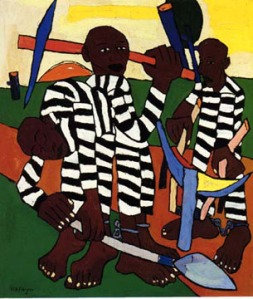I picked this theme because it was always a big part of my life in my community. We had a great number of Native Americans in my class when I was little, so we did a lot of activities that involved us exploring outside and learning about their customs.
Lisa Fifield is the first artist that I choose, because she is part of an Indian tribe so being “one with the land” is important in her life. She was born in 1957 and is a part of the Oneida Tribe of Indians of Wisconsin. She was diagnosed with Lupus after noticing a slight twitch in her right hand. She needed and outlet and was encouraged to start painting by a doctor to start painting.

Birch Bark Woman
I choose this painting becasue of how litterally the manis a part of the world. He is so one with her suroundings that he is a tree. This painting is really what inspired me to make my theme because I like how this shows Native American’s culture of believing everything is connected.

Helen Hide Bird
I liked this painting because even though its just a woman dancing, to me it says that she is dancing with nature. With the birds all around her it seems to me that she is dancing and maybe comunicating with the animals and the earth.

Murder of Crows
At first I wasnt sure about this painting, but after taking the title into consideration I think I got it. I fell that this conncects to my theme becase the painting is about a funeral. Crows circling like that and a group of people, it just seems like there was a death so everyone is mourning. Back to why it connects to my theme, is because everyone is gathered around the tree, and I remember learning about how some Native Americans burried their loved ones right next to a tree, so the tree could absorb their spirt and they could still be a part of this world.

The Bird Funeral
This one really spoked to me because there are so many ways to inturptet this painting. What I see and what made me connect it to my theme is even though the bodies have birds head, I beilieve that its people, who are mourning or respecting this birds death. The reason that their heads been transformed into bird heads is because they are trying to connect themselves to this bird, so they imagine themselves as a bird and what kind they would be.

James Garfield
*None of the creation dates for these peices were available, they were all painting between 1990-present*
The next artist that I chose is Maya Lin, who designed and created the Vietnam Veterans Memorial in 1985. She won the ability to create this memorial at the age of 21, and was still and undergraduate in school. She is a commited environmentalist and is working on her last peice What is Missing? which is about the loss of habitat around us.

This wall amazes me everytime I see a picure of it. Seeing how far the names go and to think that every name was a brother, father, son, uncle, grandfather, it tuggs on my heart. I choose this as the last peice of my gallary because I think that it really makes people think and it brings a different meaning to ‘A Part of the Land’. All these men gave up their lives for America and when they came home they werent even appreciated. This wall connects to my theme because these men fought for our land, our country, and by having this memorial they can always be remembered for what they did for America.
Resorces
Blackboard lesson 8
http://0.tqn.com/d/dc/1/0/C/O/1/vietnam-memorial-wreath.jpg for the V.V.M, picture















